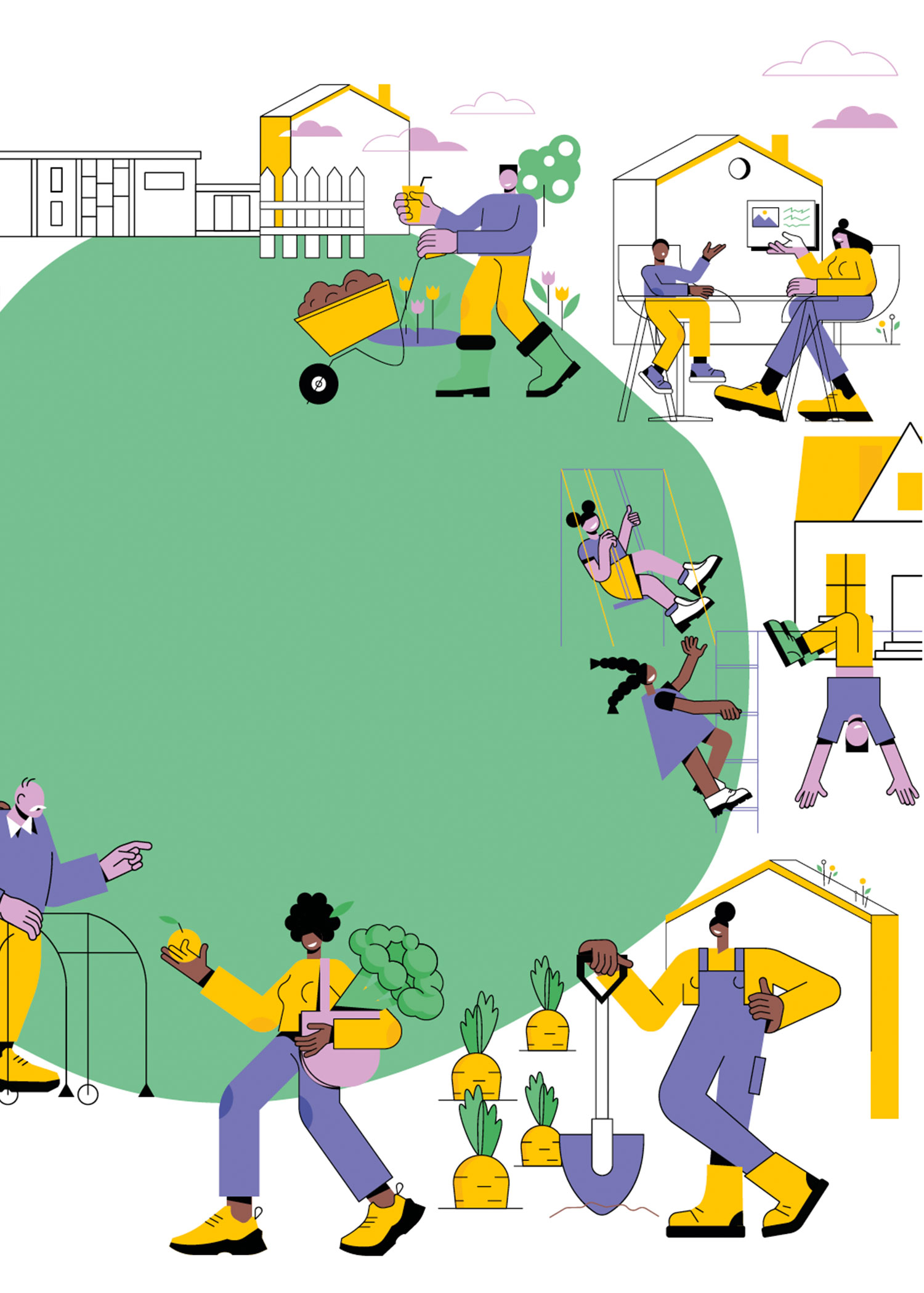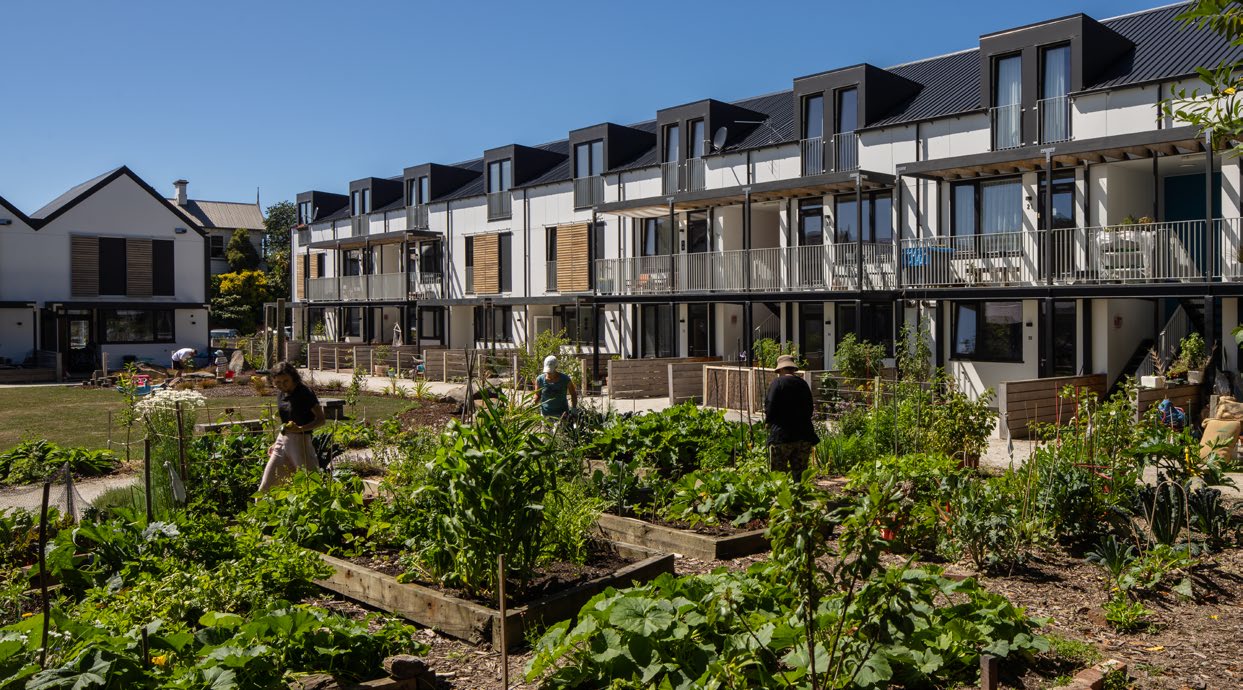

Come Together
Is communal living a wiser use of resources and a counter to societal ills like loneliness? With the cost of both newly built and older homes rocketing and a lack of supply, proponents of shared or co-housing say it’s time to reconsider once-radical options.
By Eric Trump
In Dunedin, the residents of 24 energy-efficient homes on a hill overlooking the city share a trampoline, a vegetable garden and, sometimes, dinner. In Raglan, two sisters are recreating the bonds of their happy childhood by raising their own children together. In Auckland, Ngāti Whātua Ōrākei are housing their people in award-winning, architecturally designed terrace homes. All are co-housing arrangements — modern examples of communal living.
Co-housing is the latest iteration of “intentional living” in New Zealand. At its heart, co-housing brings together private dwellings around a shared space and facilities, redefining what a neighbourhood looks like. The pleasures of privacy are braided with those of a community — one that is planned, owned and managed by the residents themselves, usually without a property developer. Existing co-housing communities, such as Cohaus in Grey Lynn, Auckland (opened in 2021), Earthsong in the West Auckland suburb of Rānui (established in 1995) and Toiora in Dunedin (conceived in 2013), represent a possible exit from New Zealand’s current double predicament of unaffordable and shoddy housing stock.
Though co-housing has not by any means gone mainstream in New Zealand — the number of projects is still low and failures probably outnumber durable successes — interest in the idea is growing. Mark Southcombe, an associate professor at Victoria University of Wellington’s School of Architecture and an expert in the history and design of co-housing, says co-housing is an arrangement whose time has come. He believes that, one day, it could compose 5 to 10 per cent of New Zealand’s housing sector.
“All we need for co-housing to make greater strides is for the right systems to be put into place so that these communities can begin and flourish.”
The model of co-housing that interests many in New Zealand today got its start in Denmark in 1972, with a community called Saettedamen 30 miles north of Copenhagen. Denmark now has hundreds of bofoellesskaber, or “living communities”, comprising about 50,000 Danes in all. The idea evolved out of a desire for affordable housing and a greater sense of community than single-family homes provide. Early co-housing residents also wanted to live in a way that would protect the environment. These communities were in theory open to all ages and ethnicities. Through their very design they are meant to encourage daily co-operation.
Similar ideas were not unknown in Aotearoa. Many different groups of people at different times have broken off from mainstream society to forge a fresh path and make a better life in intentional communities. Literature about intentional communities points to them having at least two features in common: they are composed of five or more adults and children from more than one nuclear family, and they cohere with a purpose, a vision or a goal. This might be living sustainably, obeying a god or, as was the case in the Anahata Community, established in 2000 on the site of Auckland’s infamous Centrepoint Community, making “handmade educational jigsaw puzzles”.
Some intentional communities here have had a more urgent and focused intent than others — namely, tino rangatiratanga and resistance. Parihaka in Taranaki is one. Founded by Te Whiti-o-Rongomai and Tohu Kākahi in the mid-1860s, it was the centre of a non-violent movement objecting to land alienation by the settler government. Members of the Parihaka community blocked surveyors from charting land that had been confiscated after war a decade earlier, which so enraged the colonial government that the settlement was brutally invaded and shut down in 1881. Following in the footsteps of Te Whiti and Tohu, in 1907 Rua Kenana founded his own religious community at Maungapōhatu, whose residents, the Iharaira or Israelites, also resisted land alienation.
These Māori communities of resistance were in turn an inspiration for what might be the best-known intentional community in New Zealand: the poet James K Baxter’s Jerusalem. Baxter had a vision in 1968 in which he was instructed to move to Jerusalem on the Whanganui River and there found a community where “Maori and Pakeha would try to live without money or books, worship God and work on the land.” This melding of Māori and Pākehā traditions Baxter called the “double rainbow”. Baxter’s fame as a poet attracted legions of young people desperate to escape the “half-gallon, quarter-acre pavlova paradise” of their parents, but the community also had a dark side and did not last after Baxter’s death in 1972.
Other informal communities sprang up in the late 1960s and early 1970s. Young activist and future multi-municipalities mayor Tim Shadbolt was famously involved in a short-lived commune in Auckland, named the “People’s Republic of Gibraltar Crescent”, after his street.
In 1973 the Third Labour Government, sensing the spirit of the times and taking inspiration from the kibbutz model in Israel, set up the Ohu scheme. This programme saw Crown land leased to young people wishing to form a commune. The scheme was meant to give young New Zealanders land and housing and a chance to experiment with different social relationships, while also contributing to the building of their country. It was popular, but those interested found the application process arduous, and the government had trouble providing permits to isolated terrain.
Eight ohu were established, with only three remaining by 1983. The ohu with the greatest longevity, ceasing in 2000, was Ahu Ahu Ohu, in an isolated area of the Ahu Ahu River, a tributary of the Whanganui River, not far south of Jerusalem and now listed as “abandoned settlement” on maps. Members of this ohu spent hundreds of hours hacking through bush to build an access road. Their living and eating quarters were subject to fires and flooding. The track access trail was washed away. The land is back with the Department of Conservation now, and the bush is inexorably reclaiming the abandoned structures.
“Just don’t call us a commune. We are a community with our own houses. And you don’t have to join everyone else for dinner if you don’t feel like it.”
Given this background, when the seeds of today’s co-housing were brought to and spread in Aotearoa, they fell on a land already somewhat receptive to the idea of diverse living arrangements. Michael Payne visited Denmark in 1975 and returned with the idea of establishing a dedicated Quaker settlement in Whanganui. Eight hectares were purchased and a settlement was up and running by 1976; now with 16 homes and other shared facilities, it is going strong today.
And so word gradually spread. There are now seminars, workshops and conferences all around New Zealand and the world promoting co-housing and explaining it to the sceptical and the curious. From Whanganui to Whangārei, from Wellington to Christchurch, co-housing is being planned, coming into existence and working to overcome challenges. “I’d say established communities are in the region of 20 to 24,” says Mark Southcombe. “Though the number changes all the time with emerging projects.”
In 2019 the Housing Innovation Society held its first co-housing hui, dubbed a “cohohui”. (Regular cohohui have followed — the next one is on 23 June at Auckland University of Technology.) Representatives of collective housing projects and other urban housing initiatives gave presentations at the gathering to an audience who felt disenfranchised from the current housing market. The hui’s founding statement acknowledged the grim reality of New Zealand’s housing crisis: “Housing in Aotearoa is in crisis. Whether it’s housing quality, cost, or the fact that a growing number of people are living in isolation, the current approach to housing is not addressing these key issues . . . There’s a growing appetite for new solutions.”

